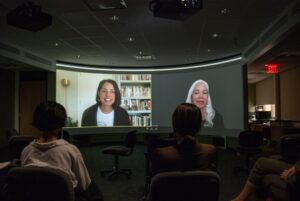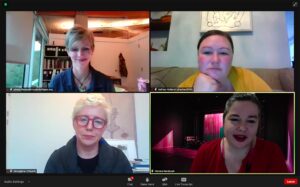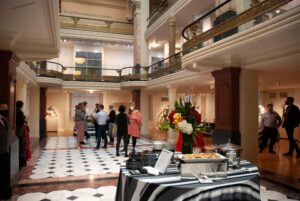Present, If Not Visible: AHAA 2021
The 2021 AHAA Symposium marked the celebration of both the fortieth anniversary of the Association of Historians of American Art (2019) and the fiftieth anniversary of the Smithsonian American Art Museum’s preeminent fellowship program (2020). AHAA’s sixth biennial symposium, originally scheduled for 2020, was delayed by the COVID-19 pandemic and ultimately hosted via Zoom one year later. Though we all missed the togetherness and vigorous applause that typically accompany the symposium, I think it’s safe to say we also appreciated the silver linings provided by this year’s virtual setting. Curling up in pajamas, rewinding prerecorded presentations to absorb as much fascinating research as possible, taking the time to write down all those burning questions for the live Q&A sessions, and having the rest of October to watch Jennifer A. González’s outstanding keynote again and again—what more could you ask for? I can’t think of a better way to sum up the 2021 AHAA Symposium than by citing González’s casual remark during the keynote Q&A: “I’ve been present even if I haven’t been visible.” These simple words simultaneously capture the experience of participating in this year’s virtual symposium and encapsulate so much of the work currently being done in the field of American art history, work that disrupts Eurocentric, colonialist, and otherwise exclusionary narratives to bring new visibility to those who have been present all along.

The final round of presentations this year, “A Land Acknowledgment is Not Enough: Why Indigenous Art Must Guide a New American Art,” considered both the presence and visibility of Indigenous voices within the discipline. Mindy N. Besaw, Ashley Holland (Cherokee Nation), Georgiana Uhlyarik, and Wanda Nanibush (Anishinaabe-kwe) prompted us not only to acknowledge the history of the lands on which we live and work but also to take the next step in our institutions by empowering Indigenous voices. During the roundtable discussion on Friday afternoon, Nanibush reminded us that “Native art is the oldest on the continent” and reiterated that Indigenous art must necessarily guide a new conception of American art (fig. 2). Although the symposium was primarily virtual, host institutions the University of Maryland (UMD) and the Smithsonian American Art Museum (SAAM) did acknowledge their respective locations on “the ancestral lands of the Piscataway people . . . and the labor of those who were enslaved in constructing” their historic buildings; asked attendees to “consider the many legacies of violence, displacement, migration, and settlement” that bring scholars of American art together; and reminded us that acknowledgment without action is not enough.

The symposium at UMD and SAAM brought together a veritable smorgasbord of outstanding research. Prerecorded talks became available on October 5, 2021, but events really kicked off the morning of Thursday, October 14, with the first live Q&A session for lightning-round panelists. In ten-minute rapid-fire presentations, authors Katherine Fein (speaking on ivory miniatures) and Emma Silverman on (on artist Greer Lankton) destabilized dominant narratives about race, gender, and animacy. Lucy Mounfield’s presentation on “amateur” photographer Vivian Maier and Danya Epstein’s work on Hopi artist and architect Dennis Numkena reconsidered the artists’ peripheral locations in the historical canon and questioned the boundaries of artistic categorization.
In the panel “Health and the Body,” Caitlin Beach took a fascinating look at Edmonia Lewis’s participation in Civil War relief fairs; Kristen Nassif reframed John Haberle’s vision impairment as an opportunity to meditate on the limits of vision; and Janine DeFeo examined Adrian Piper’s Food for the Spirit in relation to contemporary discourse on anorexia nervosa. Papers by Lea Stephenson on Newport portraiture and Stephen Mandravelis on the satirical nature of Charles Bird King’s still-life works looked to portraiture and still life, respectively. The fourth session, “Artists as Community Catalysts,” examined the foundational contributions of African American artists as curators and artistic innovators, with Maya Harakawa considering Romare Bearden’s two exhibitions of African American art in the 1960s and their relation to the Harlem art scene and Danielle O’Steen studying Lou Stovall’s printing workshop. The final session of the day, “Digital Epistemologies,” brought together Kay Wells, Laura Smith, and the collaborative duo of Karen Mary Davalos and Constance Cortez to discuss the incredible possibilities provided by the ever-expanding field of the digital humanities.
Presentations and roundtable discussions on Friday, October 15, included research focused on the three I’s: iconography, iconoclasm, and imperialism. The “Iconographies of Ethnicity” panel focused on nineteenth-century ethnic groups. Patricia Johnston examined the concept of the Italian “image peddler”; Erika Pazian highlighted the significance of images of Mexican women during the Mexican-American War; and Colleen Stockmann explored the analogous relationship between plants and people by considering white Northerners who founded New York’s Society for the Advancement of Truth in Art. A roundtable comprised of Dana Byrd, Ellery Foutch, Philippe Halbert, JoAnne Mancini, and John Ott questioned the motivations behind and consequences of art destruction in “Iconoclasm in North America,” led by Wendy Bellion and Jennifer Van Horn. And the far-reaching legacies of American imperialism were interrogated by Maggie Cao in a paper on Winslow Homer’s Gulf Stream, by Ellen Tani in a study of Senga Nengudi’s “Afro-Asian” sculpture, and by Mallory Nanny in relation to An-My Lê’s Small Wars, a work about the Vietnam War and its reverberations.
The culminating virtual event was González’s keynote, “Speech and Silence,” which streamed live and centered on Theresa Hak Kyung Cha and Sharon Hayes. González argued that both contemporary artists demonstrate “how silence can be a form of political speech” through their work. Jordana Moore Saggese moderated an engaging Q&A (see fig. 1).

Finally, on Saturday morning, those in the Washington, DC, area and able to attend in-person events were treated to an enlightening tour of the exhibition American Landscapes: Nature, Beauty, History at the University of Maryland’s David C. Driskell Center (fig. 3). The show presents a comprehensive narrative of African Americans’ contribution to the American landscape tradition from the nineteenth century to today by juxtaposing African-American artists with their contemporaries. In the afternoon, attendees regrouped at SAAM for tours of Sargent, Whistler, and Venetian Glass: American Artists and the Magic of Murano, led by curator Crawford Alexander Mann III, and Welcome Home: A Portrait of East Baltimore, 1975–1980, led by curator John Jacob and curatorial fellow Krystle Stricklin.
Fig. 3. AHAA members gather at the David C. Driskell Center to view the American Landscapes exhibition led by graduate assistant Aryn Grace Neurock (second from left), 2021 AHAA Symposium, October 1

AHAA’s sixth biennial symposium concluded with wine and conversation in the Luce Foundation Center for American Art at SAAM (fig. 4). Although we had to wait an extra year to come together for this symposium, it was wonderful to be present—even if we weren’t all visible.
Cite this article: Ashley Cope, “Present, If Not Visible: AHAA 2021,” Panorama: Journal of the Association of Historians of American Art 7, no. 2 (Fall 2021), https://journalpanorama.org/article/present-if-not-visible/.
PDF: Cope, Present, If Not Visible
About the Author(s): Ashley Cope is a Master’s Student in the Department of Art History and Archaeology at the University of Maryland

